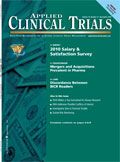M&A in the Pharma Industry
Applied Clinical Trials
Organizations are seeking growth and competitive advantage through mergers and acquistions.
The pharmaceutical industry has been ripe with merger and acquisition activity for the last several years and it is expected to continue for another 12 to 18 months. This profound increase in activity can be attributed to a variety of direct and indirect factors, such as impending healthcare reform in the US, increased regulatory pressure, non-robust development pipelines, and increased generic competition. The drivers of M&A activity warrant an honest and introspective look at the industry and what the organizations that comprise it are experiencing today.
In this era of economic uncertainty and increased pressure on margins, organizations that possess the bandwidth are seeking growth and a competitive advantage through M&A transactions. Results from Aon Hewitt's new survey, Human Capital and the Success or Failure of M&A, reflect this trend. For example, 59 percent of finance and human resource executive participants stated that adding complimentary products, brands, or service lines ranked among their companies' primary objectives for M&A over the past two years.
Survey results also reflect a trend towards gaining access to new markets. Fifty-two percent of participants in this survey indicated that gaining access to new markets ranked among their primary M&A objectives. Within the evolving pharmaceutical industry, some companies are gaining a competitive advantage by balancing their portfolios with service line extensions into the generic and consumer product offerings. This growth trend is particularly relevant for pharmaceutical companies and CROs that have been prospecting pharmaemerging regions, such as India and more recently Latin America, for several years from a manufacturing/clinical perspective and now also from a market perspective.
Regardless of the impetus and strategic drivers, what truly facilitates a successful M&A transaction? This really depends on a successful and appropriately proportioned blend of the correct understanding, resources, and expectations in the context of the specific time and industry, taking into account all internal and external factors. Often times the term "M&A" evokes a notion of something insurmountable, but with the correct forethought and process it can be managed utilizing the same structure, process, and communication mechanisms that are attributed to other successful projects.

TOM MERTON/GETTY IMAGES
The following are several factors that should be considered for effectively managing M&A activities.
Understand the type of transaction
First, it is important to recognize that all transactions are not the same. Failing to realize this can result in extra effort and directional and structural modifications that don't necessarily add value or are not required. Being cognizant of the type of transaction ensures customization of an approach that leverages appropriate resources, disciplines, and tools in the execution of a successful integration lifecycle. Though the exact names can vary, there are four major types of transactions:
- Expansion: The primary focus is on infrastructure, shared services, and platform synergies for realizing the main cost efficiencies.
- Transformation: This approach typically requires full integration in both front- and back-office functions and requires a dedicated, structured effort to realize significant change across the enterprise.
- Bolt-on: Minimal structural changes are required as the target organization is typically quite smaller in size relative to the acquirer.
- Tuck-in: These integrations are typically fast paced and directive in nature with the target organization being integrated and rationalized within the acquirer's organization.
Strategy alignment
Once the type of transaction is recognized, an organization should deliberately review the organization's new strategy. This will have implications on all aspects of integration that can range from organizational design to the core competencies required for key roles. In fact, 80 percent of participants in Aon Hewitt's survey stated that M&A plays a "major" or "contributing" role in their business strategy. In addition, 63 percent said that their organizations' top challenge in ensuring the intended value of the transaction is realized with ensuring proper alignment of the new company culture with business strategy. Nearly 80 percent of survey participants agreed that the assessment and selection of leaders greatly contributes to the financial success of a transaction. In other words, M&A is a core part of today's growth strategies amongst fast-moving industries, and human capital related issues are at the top of executives' list of success factors. In addition, in order to maximize the organizational benefit of effective leadership selection and culture alignment, it is important to implement change initiatives at the top and cascade them down through the organization in an aseptic and arbitrary manner.
Identify key success metrics
Equally important is the identification of key success metrics in order to ensure a deal meets its primary objectives. These need to be defined against the strategic agenda of the "new" organization. In client-oriented industries, three primary metrics that tend to be highly effective are employee engagement/retention, client satisfaction, and the achievement of financial targets. While the financial variable in this trifecta is often considered the most important, the interdependency and impact of the other two variables on the financial success of the transaction should not be overlooked or underestimated. These three metrics are very much co-dependent and should be assessed and monitored with this concept in mind. For example, if employees are engaged and motivated, they will be more apt to ensure a better client experience which results in repeat business and contributes to the financial success metrics that have been identified. On the other hand, disengaged employees can have catastrophic effects on an organization that is microscopically being observed by all stakeholders. Therefore, as most staff in the industry is client facing, it is critical to maintain high levels of engagement during transaction activity so that clients experience continuity of service and, at a minimum, "business as usual."
Taking the concept of "business as usual" a step further, metrics can be used to encourage an environment focused on "better than business as usual." After all, the M&A transaction should result in additional value for all stakeholders, including clients and employees. In fact, 72 percent of participants in Aon Hewitt's survey said that employee engagement of the combined workforce was one of the variables that most strongly impacts the financial value of a transaction.
These metrics must be routinely monitored for a defined period during and beyond integration from an executive leadership vantage with special consideration towards any variance and identification of course correction to ensure the intended value of the transaction is realized. These metrics can also be utilized as a communication tool for further engagement by extrapolating the results into tangible actions for the entire organization.
Conclusion
Many organizations struggle with realizing the full potential of M&A activities, and those in the pharmaceutical industry are no different. The speed at which M&As are taking place within the pharmaceutical industry, however, has increased executives' focus on how specific human capital strategies, programs, and tools can maximize the success of transactions. Fortunately, pharmaceutical companies know the value of having a structured and value add project management approach for product development and process improvements—now it is just a matter of applying this skill set to a different type of project with the same intent of value creation and strong financial results.
Viq Pervaaz, Senior Vice President, Corporate Transactions/Transformation, Aon Hewitt, 199 Water Street, New York, NY, e-mail: viq.pervaaz@aonhewitt.com

Improving Relationships and Diversifying the Site Selection Process
April 17th 2025In this episode of the Applied Clinical Trials Podcast, Liz Beatty, co-founder and chief strategy officer, Inato, discusses a number of topics around site engagement including community-based sites, the role of technology in improving site/sponsor relationships, how increased operational costs are impacting the industry, and more.